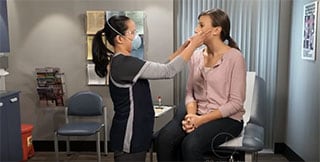Specimen Collection, Storage, Submission and Shipment
If it has been <3 days since symptom onset, collect a buccal swab specimen for detection of viral RNA by real-time (rRT-PCR). If it has been >3 days since symptom onset, collect a buccal swab specimen for rRT-PCR and a serum specimen for IgM detection. If the patient has orchitis/oophoritis, mastitis, pancreatitis, hearing loss, meningitis, or encephalitis, collect a buccal swab specimen for rRT-PCR and a serum specimen for IgM detection, regardless of days since symptom onset. A single serum specimen tested for mumps specific IgG is not useful for diagnosing acute mumps infections. A fourfold rise or seroconversion is rarely demonstrated between paired serum specimens for mumps since IgG is typically present at symptom onset (see serology FAQ).
At the onset of a suspected mumps outbreak, patients suspected to have mumps should be tested by rRT-PCR to confirm mumps and rule out other possible etiologies. However, once a mumps outbreak is confirmed, jurisdictions should consider alternate strategies to ensure efficient use of resources available for laboratory testing.
The laboratory criteria for the Council of State and Territorial Epidemiologists case definition for mumps designates mumps cases with confirmatory laboratory evidence (including those with a positive rRT-PCR result) as confirmed, while cases that are IgM positive and meet the clinical criteria of ≥2 day-duration of parotitis or other salivary gland swelling or with a mumps-related complication are classified as probable. Those with an IgM positive result that do NOT meet the clinical criteria are classified as suspect only if there is documentation that mumps was suspected.
Please contact your state or local health department to determine where to submit specimens and how to ship them.
Submission of specimens to CDC
The CDC Infectious Diseases Laboratories provides guidance for mumps specimen collection, storage, and shipment. Refer to the Infectious Diseases Laboratories Test Directory entry for each test, see links below, for instructions on specimen collection, storage, and shipment as well as points of contact for the tests.
Serology (serum specimen):
Real-time RT-PCR (buccal swab specimen):
In addition to the information found on the CDC Infectious Diseases Laboratories Test Directory entry for Mumps Detection (Test CDC-10544), please note the following regarding buccal swab specimens:
Video: “Collecting a Buccal Swab Clinical Specimen for Mumps Diagnostic Testing.”
This short video demonstrates how to correctly collect and transport a buccal swab for the detection of mumps virus.
If instructed to send specimens to CDC from within the U.S., you must use the CDC Specimen Submission Form (50.34) and submit one form per specimen. The form can be downloaded from the CDC Infectious Diseases Laboratories’ Test Directory website. Please provide a Specimen Submission Form (50.34) for each specimen submitted. Submitters are encouraged to use the CDC Specimen Test Order and Reporting (CSTOR) Web Portal to submit specimens.
Please be sure to include the following information:
- Contact name with telephone number and email address
- Case ID and specimen ID from the submitting laboratory associated with the specimen
- Type of specimen, transport media (if applicable), and date collected
- MMR vaccination history [date(s) if known]
- Clinical signs and symptoms
- Patient’s date of birth or age
- Onset date of parotitis or jaw swelling if applicable
- Any previous test results (if known)
References
- Hatchette TF, Mahony JB, Chong S, LeBlanc JJ. Difficulty with mumps diagnosis: what is the contribution of mumps mimickers? J Clin Virol 2009; 46:381-3.
- Jin L, Feng Y, Parry R, Cui A, Lu Y. Real-time PCR and its application to mumps rapid diagnosis. J Med Virol 2007; 79:1761-7.
- Krause CH, Eastick K, Ogilvie MM. Real-time PCR for mumps diagnosis on clinical specimens–comparison with results of conventional methods of virus detection and nested PCR. J Clin Virol 2006; 37:184-9.
- L’Huillier AG, Eshaghi A, Racey CS, et al. Laboratory testing and phylogenetic analysis during a mumps outbreak in Ontario, Canada. Virol J 2018; 15:98.
- Maillet M, Bouvat E, Robert N, et al. Mumps outbreak and laboratory diagnosis. J Clin Virol 2015; 62:14-9.
- Nunn A, Masud S, Krajden M, Naus M, Jassem AN. Diagnostic Yield of Laboratory Methods and Value of Viral Genotyping during an Outbreak of Mumps in a Partially Vaccinated Population in British Columbia, Canada. J Clin Microbiol 2018; 56.
- Tan KE, Anderson M, Krajden M, Petric M, Mak A, Naus M. Mumps virus detection during an outbreak in a highly unvaccinated population in British Columbia. Can J Public Health 2011; 102:47-50.
